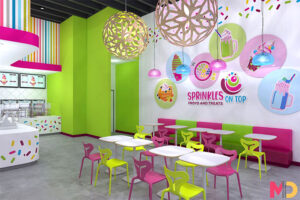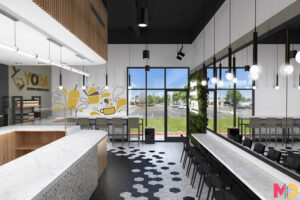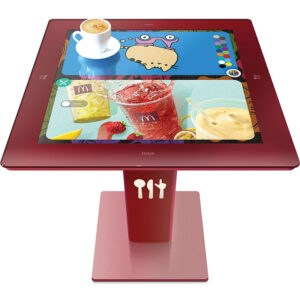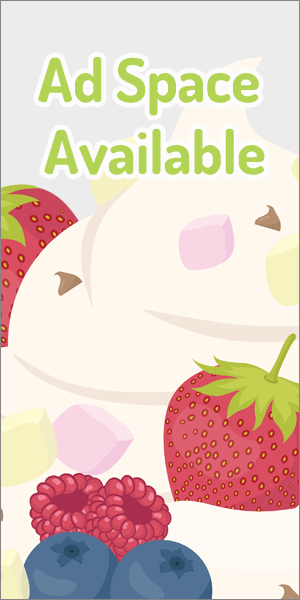This article was contributed by Mindful Design Consulting a commercial interior design and branding agency located in San Diego, California.
Beginning with the first froyo movement of the 1980s, the public’s love for frozen yogurt became a solid and enduring presence in the dessert world. Today, customers continue to search for healthier alternatives to traditional desserts, keeping froyo shops going strong. However, shop owners are trying to keep up with customers’ quest for the newest dessert craze and to appeal to the Instagram and TikTok-hungry crowd.
This translates into several trends in both the design of froyo shops and the way they operate. Here are a few ways store owners are trying to remain competitive, and what it all means for their shops’ interior design.
Embracing new design styles and color schemes
Traditionally, frozen yogurt shops tend to be designed as fun places with cheerful colors. After all, customers eat first with their eyes, and the vibrant color scheme of the shop can stimulate their appetite by suggesting the flavors of the treats. Furthermore, creating good memories that convince customers to return is easier to do in a playful and dynamic environment.
While this tendency remains, there is more freedom today in the way froyo shop owners approach the problem of interior design. More subdued and sophisticated styles are gaining ground, putting forward elegant color schemes and design elements that are more relaxing than energizing. This trend is a response to an increasingly refined clientele on the quest for beauty, who appreciates both color and subtlety.
Paying more attention to lighting
While the importance of good lighting in commercial design is nothing new, frozen yogurt store owners have started to pay even more attention to it, and with good reason. Of course, lighting is one of the few elements of design that can completely change the look of an interior and make the space shine for a relatively small investment.
But good lighting is not an optional addition. In fact, the wrong light rendition can make a space look dreadful even if the owners have spent a lot of money on finishes. The design of the light fixtures plays an important role in the overall look of the store. The owners who take the time to improve the ceiling landscape and turn it into a design feature with beautiful lighting take advantage of an element that too many might ignore.
However, there is an additional reason why frozen yogurt shop owners should weigh their lighting choices carefully. In a time when photo sharing has become a serious promotional tool, owners need to make their lighting conducive to taking pictures. Considering the placement of the tables, the direction and intensity of the light, as well as how it blends with the natural light can make their desserts look best and give customers what they need to take pictures worth sharing.
Designing shop interiors with social media in mind
With Instagram and TikTok users looking for the perfect spot to capture their next dessert or fun experience, more froyo shop owners are creating shop interiors that cater to this need. Selfie walls and eye-catching murals are the quickest way to turn a store into an attractive backdrop for photos, and to harness the considerable marketing power of social media. They allow customers to become part of a story captured in a dynamic background, play out a role, send a message, or simply snap a funny or colorful picture.
3D murals that make customers part of an imagined adventure, large images of appetizing desserts, pop art or magazine collages, inspirational quotes, cityscapes, or even unique oversized logos can all turn into a point of attraction and draw in the social media–savvy customers. When done right, the whole interior can become an ideal photo-op. Colorful palettes, nostalgic themes, distinctive floors and finishes, creative signage, unique lighting accents, or oversized photo props can provide the ideal background for fantastic pictures.
In addition, an increasing number of froyo shop owners go to great lengths to create more camera-ready versions of their desserts. More layers, colors, or toppings, as well as unique packaging, need only the enthusiasm of a few customers with a social media following to become the next trend.
Adding neon signs
Having proven their potential in the commercial interior designs of the 1970s, neon signs have maintained their popularity to this day. Conspicuous and bold yet warm and comforting, neon signs draw in customers, create ambiance, and provide an additional irresistible backdrop for pictures. Given their energy-efficient construction, more frozen yogurt shops are incorporating them into their interior or exterior designs to take advantage of their visual impact and decorative qualities.
Neon signs can capture and communicate a message, make a logo stand out, finish off a decorative wall, or serve as a singular light source for an intimate corner. While they can be colorful and flashy, neon signs can also be a part of a simpler tone-on-tone design for frozen yogurt shops that go for a more subtle look.
Rethinking the layout to make the most of a limited prep area
To attract more customers with both traditional and trendy treats, some new and old yogurt shop owners are adding more items to their menus. Bubble tea, milk shakes, and acai bowls for the health-conscious, all appeal to the hip young customers that want their desserts to be “cool” and photo-worthy. From monster shakes to endless bubble tea variations served in illuminated lightbulb-shaped glasses, these treats are ultra-photogenic and highly satisfying.
Simultaneously, offering traditional items such as waffles, crepes, or ice cream on the menu appeals to those less inclined to try something new and brings in the comfort-seeking crowd. Combining these items into unique desserts gives them an edge and takes them to Instagrammable levels.
However, these food additions require more space to prepare, forcing many shop owners to walk a fine line between the desire to diversify their menu and the ability to prepare the new treats. They solve the problem by rethinking the limited space they usually have, and by being highly selective when choosing items or methods of preparation that don’t require much space.
At the same time, adding a grease trap for collecting fat particles from milk and baked products may become a necessity. While there are certain ways to avoid this extra cost by staying away from greasy desserts, many dessert shop owners choose to add these items to their menus despite their drawbacks, in order to be more appealing to customers.
Introducing interactive self-ordering
While still not in the mainstream, interactive self-ordering is slowly making an appearance in some dessert shops. This ordering technology comes in many forms, including iPad stations or even smart tables with built-in menus. It can minimize the stress of hiring and reduce the employee workload, while offering customers much more information and even entertainment.
For instance, the Interactive Restaurant Technology (IRT) smart tables from the Kyiv-based company Kodisoft allow customers to view the menu (complete with pictures of the menu items, ingredients and nutritional value), place their order, pay, and even write reviews. In addition, it provides entertainment, where customers can play games, browse social media, share content from a smartphone or message other tables.
The advantages of such a system and the attraction it has for prospective customers are evident. Smart tables reduce wait time, offer in-depth information without the need for additional menus or tablets, serve as recreation tools and have the “cool” factor that can provide a competitive edge.
About Mindful Design Consulting
Mindful Design Consulting is a commercial design agency located in San Diego, California. The company works with small to medium businesses to create unique interiors that promote positive customer experiences. With extensive knowledge of eco-friendly building materials and methods, as well as the psychological effects of interior design, Mindful Design Consulting strives to make people healthier and happier through everything it builds. The company creates unique, recognizable looks that help form brand-related memories and convince customers to come back. Its portfolio includes more than 300 completed projects in the United States and abroad, including restaurants, dessert shops, bars, hotels, retail spaces, offices, salons, malls, and hotels.







